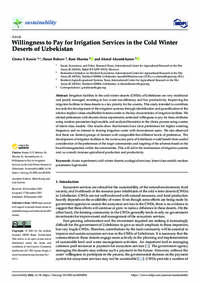Willingness to Pay for Irrigation Services in the Cold Winter Deserts of Uzbekistan

Authors:
Irrigation facilities in the cold winter deserts (CWDs) of Uzbekistan are very traditional and poorly managed, resulting in low water use efficiency and low productivity. Improving the irrigation facilities in these deserts is a key priority for the country. This study intended to contribute towards the development of the irrigation systems through identification and quantification of the relative implicit values smallholder farmers confer to the key characteristics of irrigation facilities. We elicited preferences with discrete choice experiments, estimated willingness to pay for these attributes using random parameters logit models, and analyzed heuristics in the choice process using a series of latent class models. Our results show that farmers have clear preferences for higher watering frequency and no interest in sharing irrigation water with downstream users. We also observed that there are distinct groups of farmers with comparable but different levels of preference. The development of irrigation facilities in the water-scarce parts of Uzbekistan would benefit from careful consideration of the preferences of the target communities and targeting of the schemes based on the broad heterogeneities within the communities. This will aid in the maintenance of irrigation systems and, as a result, increase agricultural production and productivity.
